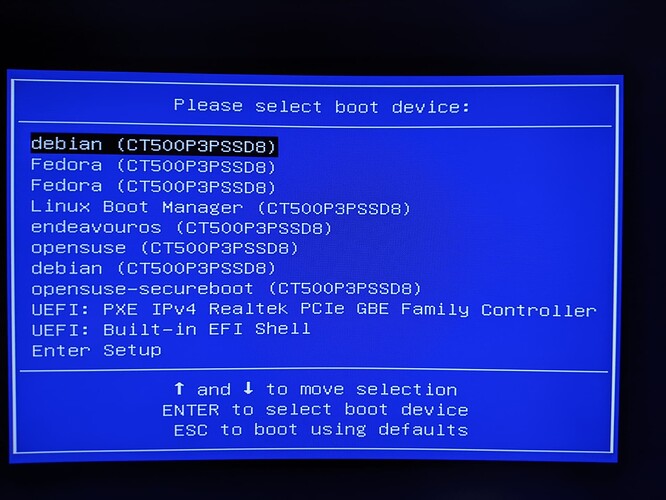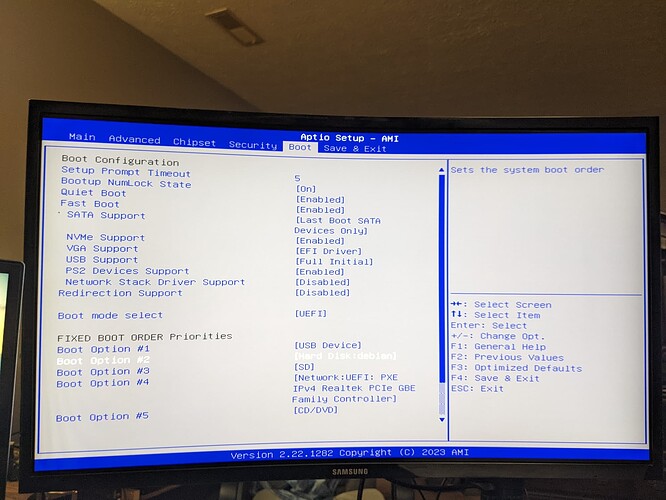@nevj , that is a new entry for the Linux notebook. The article helped me get the complete list so I can manage it via CLI.
I think because this came with W11 installed on it, this is like the “Start Menu” I recall from Windows you can get into before the OS loads. I remember it had things like safe mode, etc. That appears (below) to be the Boot0000 Windows Boot Manager so I assume that is what this start menu is.
The article does show you how to change the boot order, delete entries, etc. But I am unsure which of these applies to the author’s statement:
“You can see the EFI system partition number, the partition table type (GPT), UUID of the EFI system partition and the boot loader file.”
Here is my verbose output:
BootCurrent: 000B
Timeout: 5 seconds
BootOrder: 000D,0006,0002,0004,0005,0009,000B,000C,0007,0003,0001
Boot0000* Windows Boot Manager HD(1,GPT,7638681a-9f6b-455f-ae71-925f6058e0db,0x800,0x32000)/File(\EFI\MICROSOFT\BOOT\BOOTMGFW.EFI)57494e444f5753000100000088000000780000004200430044004f0042004a004500430054003d007b00390064006500610038003600320063002d00350063
00640064002d0034006500370030002d0061006300630031002d006600330032006200330034003400640034003700390035007d0000006f000100000010000000040000007fff0400
dp: 04 01 2a 00 01 00 00 00 00 08 00 00 00 00 00 00 00 20 03 00 00 00 00 00 1a 68 38 76 6b 9f 5f 45 ae 71 92 5f 60 58 e0 db 02 02 / 04 04 46 00 5c 00 45 00 46 00 49 00 5c 00 4d 00 49 00 43 00 52 00 4f 00 53 00 4f 00 46 00 54 00 5c 00 42 00 4f 00 4f 00
54 00 5c 00 42 00 4f 00 4f 00 54 00 4d 00 47 00 46 00 57 00 2e 00 45 00 46 00 49 00 00 00 / 7f ff 04 00
data: 57 49 4e 44 4f 57 53 00 01 00 00 00 88 00 00 00 78 00 00 00 42 00 43 00 44 00 4f 00 42 00 4a 00 45 00 43 00 54 00 3d 00 7b 00 39 00 64 00 65 00 61 00 38 00 36 00 32 00 63 00 2d 00 35 00 63 00 64 00 64 00 2d 00 34 00 65 00 37 00 30 00 2d 00 61 00 6
3 00 63 00 31 00 2d 00 66 00 33 00 32 00 62 00 33 00 34 00 34 00 64 00 34 00 37 00 39 00 35 00 7d 00 00 00 6f 00 01 00 00 00 10 00 00 00 04 00 00 00 7f ff 04 00
Boot0001* UEFI: Built-in EFI Shell VenMedia(5023b95c-db26-429b-a648-bd47664c8012)0000424f
dp: 04 03 14 00 5c b9 23 50 26 db 9b 42 a6 48 bd 47 66 4c 80 12 / 7f ff 04 00
data: 00 00 42 4f
Boot0002* Fedora HD(1,GPT,e67afbcc-d2a6-4683-aae1-5ce9852bfd72,0x800,0x12c000)/File(\EFI\FEDORA\SHIMX64.EFI)
dp: 04 01 2a 00 01 00 00 00 00 08 00 00 00 00 00 00 00 c0 12 00 00 00 00 00 cc fb 7a e6 a6 d2 83 46 aa e1 5c e9 85 2b fd 72 02 02 / 04 04 34 00 5c 00 45 00 46 00 49 00 5c 00 46 00 45 00 44 00 4f 00 52 00 41 00 5c 00 53 00 48 00 49 00 4d 00 58 00 36 00
34 00 2e 00 45 00 46 00 49 00 00 00 / 7f ff 04 00
Boot0003* UEFI: PXE IPv4 Realtek PCIe GBE Family Controller</span> PciRoot(0x0)/Pci(0x1,0x2)/Pci(0x0,0x0)/MAC(b0416f0c3d76,0)/IPv4(0.0.0.00.0.0.0,0,0)0000424f
dp: 02 01 0c 00 d0 41 03 0a 00 00 00 00 / 01 01 06 00 02 01 / 01 01 06 00 00 00 / 03 0b 25 00 b0 41 6f 0c 3d 76 00 00 00 00 00 00 00 00 00 00 00 00 00 00 00 00 00 00 00 00 00 00 00 00 00 00 00 / 03 0c 1b 00 00 00 00 00 00 00 00 00 00 00 00 00 00 00 00
00 00 00 00 00 00 00 00 / 7f ff 04 00
data: 00 00 42 4f
Boot0004* Fedora HD(1,GPT,e67afbcc-d2a6-4683-aae1-5ce9852bfd72,0x800,0x12c000)/File(\EFI\FEDORA\SHIM.EFI)0000424f
dp: 04 01 2a 00 01 00 00 00 00 08 00 00 00 00 00 00 00 c0 12 00 00 00 00 00 cc fb 7a e6 a6 d2 83 46 aa e1 5c e9 85 2b fd 72 02 02 / 04 04 2e 00 5c 00 45 00 46 00 49 00 5c 00 46 00 45 00 44 00 4f 00 52 00 41 00 5c 00 53 00 48 00 49 00 4d 00 2e 00 45 00
46 00 49 00 00 00 / 7f ff 04 00
data: 00 00 42 4f
Boot0005* Linux Boot Manager HD(1,GPT,e67afbcc-d2a6-4683-aae1-5ce9852bfd72,0x800,0x12c000)/File(\EFI\SYSTEMD\SYSTEMD-BOOTX64.EFI)
dp: 04 01 2a 00 01 00 00 00 00 08 00 00 00 00 00 00 00 c0 12 00 00 00 00 00 cc fb 7a e6 a6 d2 83 46 aa e1 5c e9 85 2b fd 72 02 02 / 04 04 46 00 5c 00 45 00 46 00 49 00 5c 00 53 00 59 00 53 00 54 00 45 00 4d 00 44 00 5c 00 53 00 59 00 53 00 54 00 45 00
4d 00 44 00 2d 00 42 00 4f 00 4f 00 54 00 58 00 36 00 34 00 2e 00 45 00 46 00 49 00 00 00 / 7f ff 04 00
Boot0006* HD(1,GPT,e67afbcc-d2a6-4683-aae1-5ce9852bfd72,0x800,0x12c000)/File(\EFI\DEBIAN\SHIMX64.EFI)
dp: 04 01 2a 00 01 00 00 00 00 08 00 00 00 00 00 00 00 c0 12 00 00 00 00 00 cc fb 7a e6 a6 d2 83 46 aa e1 5c e9 85 2b fd 72 02 02 / 04 04 34 00 5c 00 45 00 46 00 49 00 5c 00 44 00 45 00 42 00 49 00 41 00 4e 00 5c 00 53 00 48 00 49 00 4d 00 58 00 36 00
34 00 2e 00 45 00 46 00 49 00 00 00 / 7f ff 04 00
Boot0007* opensuse-secureboot HD(1,GPT,e67afbcc-d2a6-4683-aae1-5ce9852bfd72,0x800,0x12c000)/File(\EFI\OPENSUSE\SHIM.EFI)
dp: 04 01 2a 00 01 00 00 00 00 08 00 00 00 00 00 00 00 c0 12 00 00 00 00 00 cc fb 7a e6 a6 d2 83 46 aa e1 5c e9 85 2b fd 72 02 02 / 04 04 32 00 5c 00 45 00 46 00 49 00 5c 00 4f 00 50 00 45 00 4e 00 53 00 55 00 53 00 45 00 5c 00 53 00 48 00 49 00 4d 00
2e 00 45 00 46 00 49 00 00 00 / 7f ff 04 00
Boot0009* endeavouros HD(1,GPT,e67afbcc-d2a6-4683-aae1-5ce9852bfd72,0x800,0x12c000)/File(\EFI\ENDEAVOUROS\GRUBX64.EFI)
dp: 04 01 2a 00 01 00 00 00 00 08 00 00 00 00 00 00 00 c0 12 00 00 00 00 00 cc fb 7a e6 a6 d2 83 46 aa e1 5c e9 85 2b fd 72 02 02 / 04 04 3e 00 5c 00 45 00 46 00 49 00 5c 00 45 00 4e 00 44 00 45 00 41 00 56 00 4f 00 55 00 52 00 4f 00 53 00 5c 00 47 00
52 00 55 00 42 00 58 00 36 00 34 00 2e 00 45 00 46 00 49 00 00 00 / 7f ff 04 00
Boot000B* opensuse HD(1,GPT,e67afbcc-d2a6-4683-aae1-5ce9852bfd72,0x800,0x12c000)/File(\EFI\OPENSUSE\GRUBX64.EFI)0000424f
dp: 04 01 2a 00 01 00 00 00 00 08 00 00 00 00 00 00 00 c0 12 00 00 00 00 00 cc fb 7a e6 a6 d2 83 46 aa e1 5c e9 85 2b fd 72 02 02 / 04 04 38 00 5c 00 45 00 46 00 49 00 5c 00 4f 00 50 00 45 00 4e 00 53 00 55 00 53 00 45 00 5c 00 47 00 52 00 55 00 42 00
58 00 36 00 34 00 2e 00 45 00 46 00 49 00 00 00 / 7f ff 04 00
data: 00 00 42 4f
Boot000C* debian HD(1,GPT,e67afbcc-d2a6-4683-aae1-5ce9852bfd72,0x800,0x12c000)/File(\EFI\DEBIAN\GRUBX64.EFI)0000424f
dp: 04 01 2a 00 01 00 00 00 00 08 00 00 00 00 00 00 00 c0 12 00 00 00 00 00 cc fb 7a e6 a6 d2 83 46 aa e1 5c e9 85 2b fd 72 02 02 / 04 04 34 00 5c 00 45 00 46 00 49 00 5c 00 44 00 45 00 42 00 49 00 41 00 4e 00 5c 00 47 00 52 00 55 00 42 00 58 00 36 00
34 00 2e 00 45 00 46 00 49 00 00 00 / 7f ff 04 00
data: 00 00 42 4f
Boot000D* UEFI: USB, Partition 2 PciRoot(0x0)/Pci(0x8,0x1)/Pci(0x0,0x4)/USB(4,0)/HD(2,MBR,0xfc52a621,0x1d1e0000,0x10000)0000424f
dp: 02 01 0c 00 d0 41 03 0a 00 00 00 00 / 01 01 06 00 01 08 / 01 01 06 00 04 00 / 03 05 06 00 04 00 / 04 01 2a 00 02 00 00 00 00 00 1e 1d 00 00 00 00 00 00 01 00 00 00 00 00 21 a6 52 fc 00 00 00 00 00 00 00 00 00 00 00 00 01 01 / 7f ff 04 00
data: 00 00 42 4f
Thanks,
Sheila

